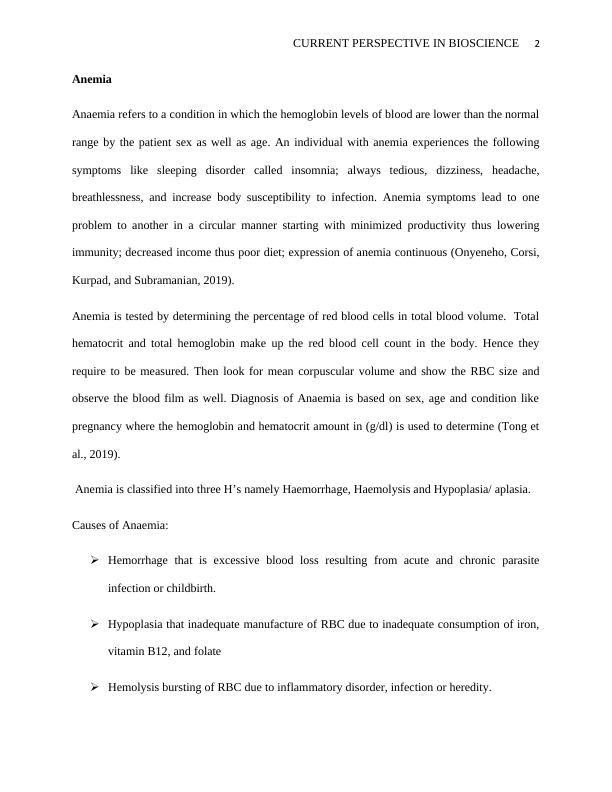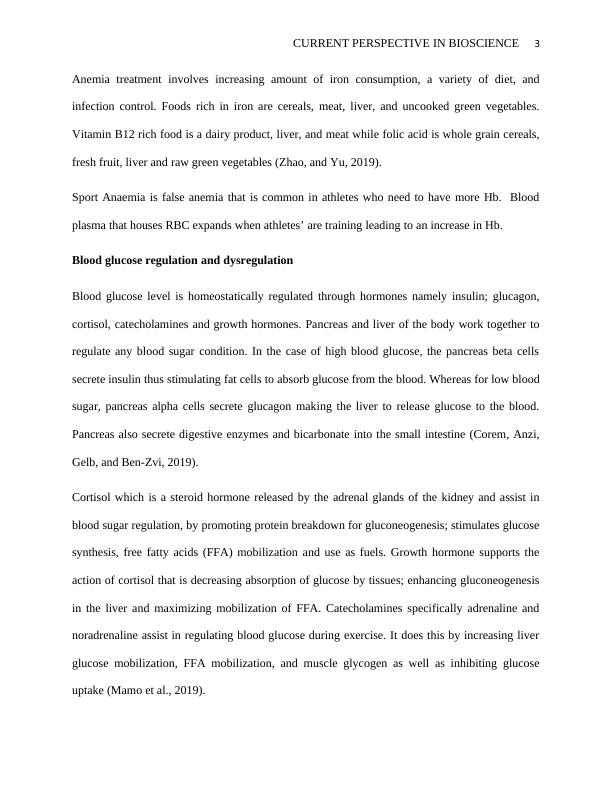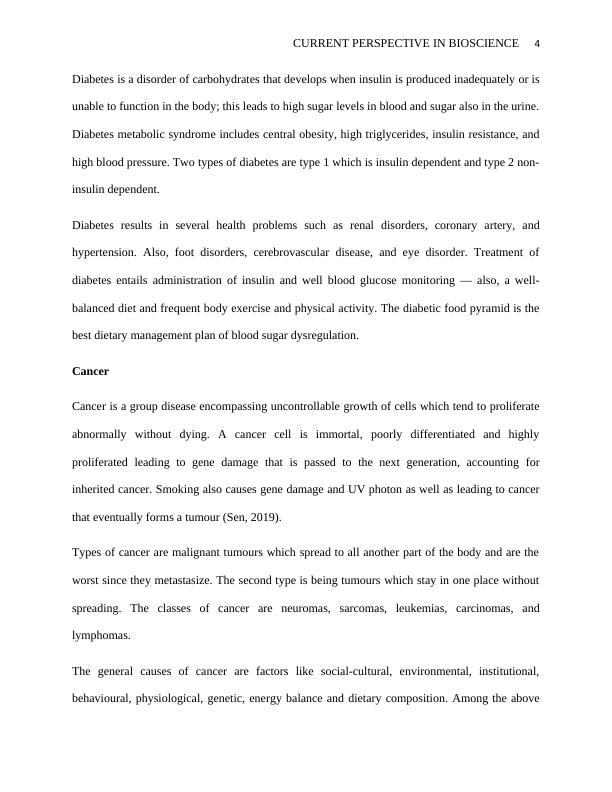Current Perspective in Bioscience
Added on 2023-01-18
16 Pages4633 Words69 Views
CURRENT PERSPECTIVE IN BIOSCIENCE 1
CURRENT PERSPECTIVE IN BIOSCIENCE
BY
Course
Professor
University
City + state
Date
CURRENT PERSPECTIVE IN BIOSCIENCE
BY
Course
Professor
University
City + state
Date

CURRENT PERSPECTIVE IN BIOSCIENCE 2
Anemia
Anaemia refers to a condition in which the hemoglobin levels of blood are lower than the normal
range by the patient sex as well as age. An individual with anemia experiences the following
symptoms like sleeping disorder called insomnia; always tedious, dizziness, headache,
breathlessness, and increase body susceptibility to infection. Anemia symptoms lead to one
problem to another in a circular manner starting with minimized productivity thus lowering
immunity; decreased income thus poor diet; expression of anemia continuous (Onyeneho, Corsi,
Kurpad, and Subramanian, 2019).
Anemia is tested by determining the percentage of red blood cells in total blood volume. Total
hematocrit and total hemoglobin make up the red blood cell count in the body. Hence they
require to be measured. Then look for mean corpuscular volume and show the RBC size and
observe the blood film as well. Diagnosis of Anaemia is based on sex, age and condition like
pregnancy where the hemoglobin and hematocrit amount in (g/dl) is used to determine (Tong et
al., 2019).
Anemia is classified into three H’s namely Haemorrhage, Haemolysis and Hypoplasia/ aplasia.
Causes of Anaemia:
Hemorrhage that is excessive blood loss resulting from acute and chronic parasite
infection or childbirth.
Hypoplasia that inadequate manufacture of RBC due to inadequate consumption of iron,
vitamin B12, and folate
Hemolysis bursting of RBC due to inflammatory disorder, infection or heredity.
Anemia
Anaemia refers to a condition in which the hemoglobin levels of blood are lower than the normal
range by the patient sex as well as age. An individual with anemia experiences the following
symptoms like sleeping disorder called insomnia; always tedious, dizziness, headache,
breathlessness, and increase body susceptibility to infection. Anemia symptoms lead to one
problem to another in a circular manner starting with minimized productivity thus lowering
immunity; decreased income thus poor diet; expression of anemia continuous (Onyeneho, Corsi,
Kurpad, and Subramanian, 2019).
Anemia is tested by determining the percentage of red blood cells in total blood volume. Total
hematocrit and total hemoglobin make up the red blood cell count in the body. Hence they
require to be measured. Then look for mean corpuscular volume and show the RBC size and
observe the blood film as well. Diagnosis of Anaemia is based on sex, age and condition like
pregnancy where the hemoglobin and hematocrit amount in (g/dl) is used to determine (Tong et
al., 2019).
Anemia is classified into three H’s namely Haemorrhage, Haemolysis and Hypoplasia/ aplasia.
Causes of Anaemia:
Hemorrhage that is excessive blood loss resulting from acute and chronic parasite
infection or childbirth.
Hypoplasia that inadequate manufacture of RBC due to inadequate consumption of iron,
vitamin B12, and folate
Hemolysis bursting of RBC due to inflammatory disorder, infection or heredity.

CURRENT PERSPECTIVE IN BIOSCIENCE 3
Anemia treatment involves increasing amount of iron consumption, a variety of diet, and
infection control. Foods rich in iron are cereals, meat, liver, and uncooked green vegetables.
Vitamin B12 rich food is a dairy product, liver, and meat while folic acid is whole grain cereals,
fresh fruit, liver and raw green vegetables (Zhao, and Yu, 2019).
Sport Anaemia is false anemia that is common in athletes who need to have more Hb. Blood
plasma that houses RBC expands when athletes’ are training leading to an increase in Hb.
Blood glucose regulation and dysregulation
Blood glucose level is homeostatically regulated through hormones namely insulin; glucagon,
cortisol, catecholamines and growth hormones. Pancreas and liver of the body work together to
regulate any blood sugar condition. In the case of high blood glucose, the pancreas beta cells
secrete insulin thus stimulating fat cells to absorb glucose from the blood. Whereas for low blood
sugar, pancreas alpha cells secrete glucagon making the liver to release glucose to the blood.
Pancreas also secrete digestive enzymes and bicarbonate into the small intestine (Corem, Anzi,
Gelb, and Ben-Zvi, 2019).
Cortisol which is a steroid hormone released by the adrenal glands of the kidney and assist in
blood sugar regulation, by promoting protein breakdown for gluconeogenesis; stimulates glucose
synthesis, free fatty acids (FFA) mobilization and use as fuels. Growth hormone supports the
action of cortisol that is decreasing absorption of glucose by tissues; enhancing gluconeogenesis
in the liver and maximizing mobilization of FFA. Catecholamines specifically adrenaline and
noradrenaline assist in regulating blood glucose during exercise. It does this by increasing liver
glucose mobilization, FFA mobilization, and muscle glycogen as well as inhibiting glucose
uptake (Mamo et al., 2019).
Anemia treatment involves increasing amount of iron consumption, a variety of diet, and
infection control. Foods rich in iron are cereals, meat, liver, and uncooked green vegetables.
Vitamin B12 rich food is a dairy product, liver, and meat while folic acid is whole grain cereals,
fresh fruit, liver and raw green vegetables (Zhao, and Yu, 2019).
Sport Anaemia is false anemia that is common in athletes who need to have more Hb. Blood
plasma that houses RBC expands when athletes’ are training leading to an increase in Hb.
Blood glucose regulation and dysregulation
Blood glucose level is homeostatically regulated through hormones namely insulin; glucagon,
cortisol, catecholamines and growth hormones. Pancreas and liver of the body work together to
regulate any blood sugar condition. In the case of high blood glucose, the pancreas beta cells
secrete insulin thus stimulating fat cells to absorb glucose from the blood. Whereas for low blood
sugar, pancreas alpha cells secrete glucagon making the liver to release glucose to the blood.
Pancreas also secrete digestive enzymes and bicarbonate into the small intestine (Corem, Anzi,
Gelb, and Ben-Zvi, 2019).
Cortisol which is a steroid hormone released by the adrenal glands of the kidney and assist in
blood sugar regulation, by promoting protein breakdown for gluconeogenesis; stimulates glucose
synthesis, free fatty acids (FFA) mobilization and use as fuels. Growth hormone supports the
action of cortisol that is decreasing absorption of glucose by tissues; enhancing gluconeogenesis
in the liver and maximizing mobilization of FFA. Catecholamines specifically adrenaline and
noradrenaline assist in regulating blood glucose during exercise. It does this by increasing liver
glucose mobilization, FFA mobilization, and muscle glycogen as well as inhibiting glucose
uptake (Mamo et al., 2019).

CURRENT PERSPECTIVE IN BIOSCIENCE 4
Diabetes is a disorder of carbohydrates that develops when insulin is produced inadequately or is
unable to function in the body; this leads to high sugar levels in blood and sugar also in the urine.
Diabetes metabolic syndrome includes central obesity, high triglycerides, insulin resistance, and
high blood pressure. Two types of diabetes are type 1 which is insulin dependent and type 2 non-
insulin dependent.
Diabetes results in several health problems such as renal disorders, coronary artery, and
hypertension. Also, foot disorders, cerebrovascular disease, and eye disorder. Treatment of
diabetes entails administration of insulin and well blood glucose monitoring — also, a well-
balanced diet and frequent body exercise and physical activity. The diabetic food pyramid is the
best dietary management plan of blood sugar dysregulation.
Cancer
Cancer is a group disease encompassing uncontrollable growth of cells which tend to proliferate
abnormally without dying. A cancer cell is immortal, poorly differentiated and highly
proliferated leading to gene damage that is passed to the next generation, accounting for
inherited cancer. Smoking also causes gene damage and UV photon as well as leading to cancer
that eventually forms a tumour (Sen, 2019).
Types of cancer are malignant tumours which spread to all another part of the body and are the
worst since they metastasize. The second type is being tumours which stay in one place without
spreading. The classes of cancer are neuromas, sarcomas, leukemias, carcinomas, and
lymphomas.
The general causes of cancer are factors like social-cultural, environmental, institutional,
behavioural, physiological, genetic, energy balance and dietary composition. Among the above
Diabetes is a disorder of carbohydrates that develops when insulin is produced inadequately or is
unable to function in the body; this leads to high sugar levels in blood and sugar also in the urine.
Diabetes metabolic syndrome includes central obesity, high triglycerides, insulin resistance, and
high blood pressure. Two types of diabetes are type 1 which is insulin dependent and type 2 non-
insulin dependent.
Diabetes results in several health problems such as renal disorders, coronary artery, and
hypertension. Also, foot disorders, cerebrovascular disease, and eye disorder. Treatment of
diabetes entails administration of insulin and well blood glucose monitoring — also, a well-
balanced diet and frequent body exercise and physical activity. The diabetic food pyramid is the
best dietary management plan of blood sugar dysregulation.
Cancer
Cancer is a group disease encompassing uncontrollable growth of cells which tend to proliferate
abnormally without dying. A cancer cell is immortal, poorly differentiated and highly
proliferated leading to gene damage that is passed to the next generation, accounting for
inherited cancer. Smoking also causes gene damage and UV photon as well as leading to cancer
that eventually forms a tumour (Sen, 2019).
Types of cancer are malignant tumours which spread to all another part of the body and are the
worst since they metastasize. The second type is being tumours which stay in one place without
spreading. The classes of cancer are neuromas, sarcomas, leukemias, carcinomas, and
lymphomas.
The general causes of cancer are factors like social-cultural, environmental, institutional,
behavioural, physiological, genetic, energy balance and dietary composition. Among the above

End of preview
Want to access all the pages? Upload your documents or become a member.
